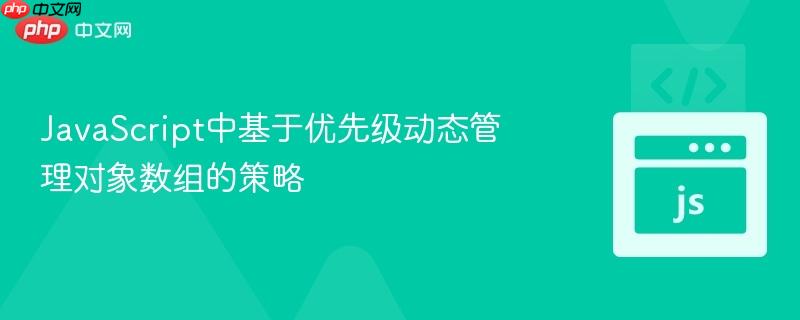
本文探讨了在JavaScript中管理带有优先级属性的对象数组时遇到的复杂问题,特别是当新对象插入或现有对象优先级更新导致与其他对象优先级冲突时。我们将分析现有解决方案的局限性,并提出一种健壮的策略,通过精确的插入和智能的级联优先级调整来确保数组的逻辑顺序和优先级规则的完整性,从而有效解决优先级冲突问题。
在许多应用场景中,我们需要管理一个对象数组,其中每个对象都含有一个“优先级”(priority)属性,用于决定其在数组中的相对重要性或顺序。例如,一个规则引擎可能需要根据规则的优先级来执行它们。然而,当用户尝试添加新规则或修改现有规则的优先级时,可能会出现优先级冲突:
这种动态管理要求不仅要能够插入或更新对象,还要智能地处理优先级冲突,并自动调整受影响的规则。
在提供的场景中,用户尝试使用BootstrapTable来展示和编辑规则,并通过beforeSaveCell和afterSaveCell回调函数来处理优先级变更。
立即学习“Java免费学习笔记(深入)”;
beforeSaveCell: (oldValue, newValue, row, column) => {
let aux = stateLinhas
aux.forEach((item, index) => {
if (parseInt(newValue) === parseInt(item.prioridade)) {
item.prioridade = parseInt(newValue) + 1
}
})
setStateLinhas(() => aux)
}这段代码的目的是在保存单元格之前处理优先级冲突。它的逻辑是遍历所有规则,如果发现有规则的优先级与newValue相同,就将其优先级加1。
局限性:
const rules = [];
function addRule() {
const priority = document.getElementById('priority').value;
const newRule = {priority: parseInt(priority)};
const index = rules.findIndex(rule => rule.priority === newRule.priority);
if (index !== -1) {
rules.splice(index, 0, newRule);
let currentPriority = newRule.priority;
rules.map((rule, i) => {
if (i > index) {
if (rule.priority === currentPriority) {
rule.priority++;
currentPriority = rule.priority;
}
}
});
} else {
rules.push(newRule);
}
console.log(rules);
}这个方案尝试通过 findIndex 找到第一个匹配的优先级,然后使用 splice 插入新规则。接着,它遍历插入点之后的规则,尝试调整优先级。
局限性:
为了实现题干中描述的“如果用户设置的优先级已存在,新规则将占据该优先级,而原规则及其后续规则将调整优先级,使其优先级至少比前一个高1”的目标,我们需要一个更精确的级联调整逻辑。
核心思想:
我们将创建一个通用函数 manageRulePriority,它可以处理添加新规则和更新现有规则两种情况。
/**
* 管理对象数组中的优先级,确保唯一性和递增顺序。
* 当插入或更新规则时,如果发生优先级冲突,将自动进行级联调整。
*
* @param {Array<Object>} rules - 原始规则数组,每个对象需包含 'id' 和 'priority' 属性。
* @param {Object} newOrUpdatedRule - 要添加或更新的规则对象。
* @returns {Array<Object>} - 经过优先级调整后的新规则数组。
*/
function manageRulePriority(rules, newOrUpdatedRule) {
// 1. 创建数组的副本以避免直接修改原始状态(对于React等框架尤其重要)
let updatedRules = [...rules];
// 确保优先级是整数
newOrUpdatedRule.priority = parseInt(newOrUpdatedRule.priority);
// 2. 检查是更新现有规则还是添加新规则
const existingRuleIndex = updatedRules.findIndex(r => r.id === newOrUpdatedRule.id);
if (existingRuleIndex !== -1) {
// 如果是更新现有规则,先将其从数组中移除
updatedRules.splice(existingRuleIndex, 1);
}
// 3. 找到新规则的逻辑插入位置
// 数组需要先按优先级排序,以便正确找到插入点
// 注意:如果数组在外部始终保持排序,此步骤可以优化
updatedRules.sort((a, b) => a.priority - b.priority);
let insertIndex = updatedRules.findIndex(r => r.priority >= newOrUpdatedRule.priority);
if (insertIndex === -1) {
// 如果新规则的优先级最高,则插入到末尾
insertIndex = updatedRules.length;
}
// 4. 插入新规则
updatedRules.splice(insertIndex, 0, newOrUpdatedRule);
// 5. 执行级联优先级调整
// 从插入点开始(或从前一个规则开始,以防插入点是0)
// 确保每个规则的优先级至少比前一个规则高1
for (let i = 1; i < updatedRules.length; i++) {
const prevRule = updatedRules[i - 1];
const currentRule = updatedRules[i];
// 如果当前规则的优先级小于或等于前一个规则的优先级
if (currentRule.priority <= prevRule.priority) {
// 将当前规则的优先级设置为前一个规则优先级 + 1
currentRule.priority = prevRule.priority + 1;
}
}
// 6. 最终排序以确保所有规则按优先级升序排列(即使经过调整)
updatedRules.sort((a, b) => a.priority - b.priority);
return updatedRules;
}
// --- 示例用法 ---
let myRules = [
{ id: 1, priority: 1 },
{ id: 2, priority: 2 },
{ id: 3, priority: 5 },
{ id: 4, priority: 6 }
];
console.log("原始规则:", JSON.parse(JSON.stringify(myRules)));
// 示例 1: 插入一个新规则,优先级与现有规则冲突 (priority 2)
let newRule1 = { id: 5, priority: 2 };
myRules = manageRulePriority(myRules, newRule1);
console.log("插入新规则 (id:5, priority:2) 后:", JSON.parse(JSON.stringify(myRules)));
// 预期结果: [ {id:1, priority:1}, {id:5, priority:2}, {id:2, priority:3}, {id:3, priority:5}, {id:4, priority:6} ]
// 示例 2: 插入一个新规则,优先级导致级联调整 (priority 3)
let newRule2 = { id: 6, priority: 3 };
myRules = manageRulePriority(myRules, newRule2);
console.log("插入新规则 (id:6, priority:3) 后:", JSON.parse(JSON.stringify(myRules)));
// 预期结果: [ {id:1, priority:1}, {id:5, priority:2}, {id:6, priority:3}, {id:2, priority:4}, {id:3, priority:5以上就是JavaScript中基于优先级动态管理对象数组的策略的详细内容,更多请关注php中文网其它相关文章!

每个人都需要一台速度更快、更稳定的 PC。随着时间的推移,垃圾文件、旧注册表数据和不必要的后台进程会占用资源并降低性能。幸运的是,许多工具可以让 Windows 保持平稳运行。

Copyright 2014-2025 https://www.php.cn/ All Rights Reserved | php.cn | 湘ICP备2023035733号